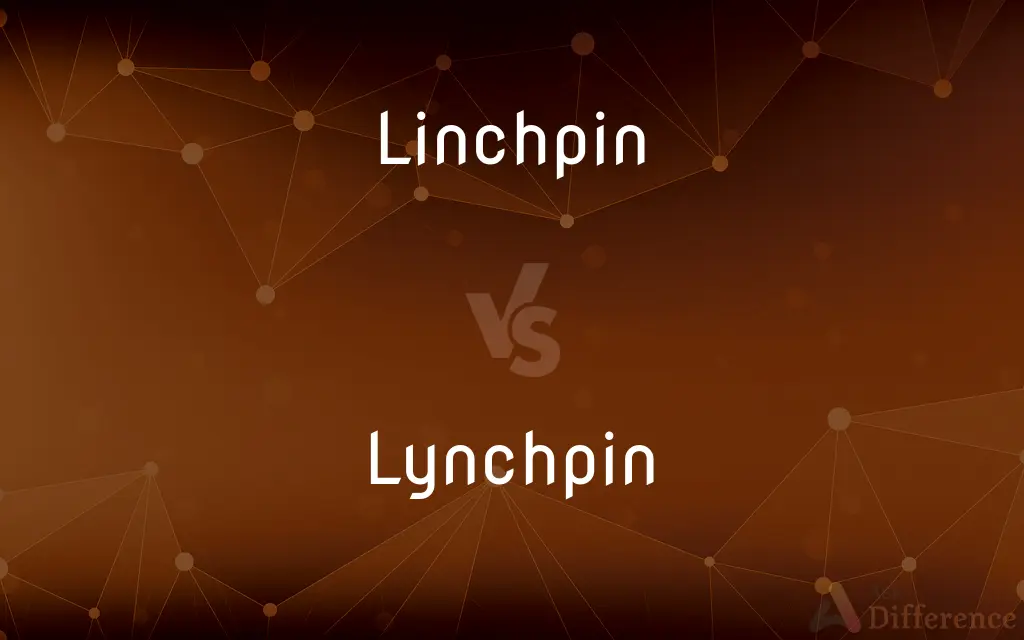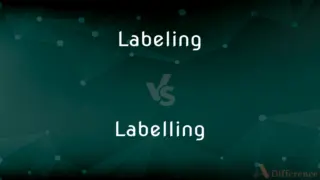Linchpin vs. Lynchpin — What's the Difference?
By Tayyaba Rehman & Urooj Arif — Updated on March 18, 2024
A linchpin is a fastener used to prevent a wheel or other part from sliding off the axle it rides on. Lynchpin, an alternate spelling, has the same physical meaning but is also used metaphorically to describe a crucial element in a system.

Difference Between Linchpin and Lynchpin
Table of Contents
ADVERTISEMENT
Key Differences
A linchpin, traditionally, is a pin passed through the end of an axle to keep a wheel in place. It is a critical component in the design of wheeled vehicles, ensuring that wheels do not come off during movement. The term "lynchpin," while often considered an alternate spelling, carries the same fundamental meaning but has been more broadly adopted in metaphorical contexts. It denotes an individual or thing that holds various elements of a complex system together, suggesting that without this key element, the system would fail to function effectively.
In physical applications, the linchpin's role is straightforward: it secures wheels or other rotating parts to axles. This practical use underscores the importance of seemingly small components in maintaining the operational integrity of larger mechanisms. Meanwhile, when used metaphorically as "lynchpin," the term emphasizes the importance of central figures or elements within organizations, projects, or any structured endeavor. This usage highlights the critical nature of certain roles or components that, while they might not always be the most visible or seemingly significant, are essential for stability and success.
The evolution of the term from a literal component to a metaphorical expression reflects a common linguistic trend where tangible objects are used to illustrate abstract concepts. In both its literal and figurative senses, the concept underscores the idea that the stability and functionality of a system—whether a physical mechanism or an organizational structure—often rely on individual components that perform indispensable roles.
Whether discussing a linchpin in its original mechanical context or using "lynchpin" to describe a pivotal component of a strategy, project, or team, the emphasis is on the irreplaceable importance of that element. Understanding the distinction between these uses is not so much about technicalities of spelling but recognizing the dual nature of the term: as both a specific physical object and a metaphor for crucial significance within any complex system.
Comparison Chart
Definition
A pin that secures a wheel to an axle.
Alternate spelling; also used metaphorically for a crucial element.
ADVERTISEMENT
Usage
Primarily physical, mechanical contexts.
Both physical and metaphorical contexts.
Significance
Prevents a wheel or part from sliding off its axle.
Describes a central, crucial element in a system.
Metaphorical Use
Less common compared to "lynchpin."
Commonly used to denote something critical to an operation.
Illustration
Integral in vehicles and machinery with wheels.
Used to highlight the importance of a person or element in maintaining the functionality of a system.
Compare with Definitions
Linchpin
Essential for the stability of wheeled vehicles.
Regular checks ensure that the linchpin is securely fastened.
Lynchpin
Reflects on the pivotal role of specific elements in maintaining stability.
Innovation is the lynchpin for a company's growth in competitive markets.
Linchpin
Used metaphorically to describe a crucial component.
In a team project, cooperation is the linchpin of success.
Lynchpin
Emphasizes the role of central components in systems or projects.
Effective communication is the lynchpin of team management.
Linchpin
Prevents the disassembly of parts under rotation.
The linchpin must be robust to withstand road vibrations.
Lynchpin
An alternative spelling of linchpin, often used in metaphorical contexts.
The CEO is seen as the lynchpin of the company's strategic direction.
Linchpin
A linchpin is a pin that keeps wheels securely attached to an axle.
The wagon's wheels were kept in place by sturdy linchpins.
Lynchpin
Highlights the indispensability of certain elements or persons.
Trust is the lynchpin of any strong relationship.
Linchpin
Symbolizes the importance of seemingly minor details.
In intricate systems, a linchpin can mean the difference between failure and success.
Lynchpin
Can refer to a critical point or factor in an argument or theory.
The witness's testimony was the lynchpin of the case.
Linchpin
A linchpin, also spelled linch pin, lynchpin, or lynch pin, is a fastener used to prevent a wheel or other part from sliding off the axle upon which it is riding. The word is first attested in the late fourteenth century and derives from Middle English elements meaning "axletree pin".Securing implements onto the three-point hitch of a tractor is an example of application.
Lynchpin
Variant of linchpin.
Linchpin
A person or thing vital to an enterprise or organization
Nurses are the linchpin of the National Health Service
Lynchpin
A central cohesive source of support and stability;
Faith is his anchor
The keystone of campaign reform was the ban on soft money
He is the linchpin of this firm
Linchpin
A pin passed through the end of an axle to keep a wheel in position.
Lynchpin
Pin inserted through an axletree to hold a wheel on
Linchpin
A locking pin inserted in the end of a shaft, as in an axle, to prevent a wheel from slipping off.
Linchpin
A central cohesive element
Reduced spending is the linchpin of their economic program.
Linchpin
A pin inserted through holes at the end of an axle or shaft, so as to secure a wheel or shaft-mounted device.
Linchpin
(figuratively) A central cohesive source of stability and security; a person or thing that is critical to a system or organisation.
Linchpin
(ambitransitive) To adopt as, or serve as, a central cohesive source of stability and security.
Linchpin
A pin used to prevent the wheel of a vehicle from sliding off the axletree.
Linchpin
A central cohesive source of support and stability;
Faith is his anchor
The keystone of campaign reform was the ban on soft money
He is the linchpin of this firm
Linchpin
Pin inserted through an axletree to hold a wheel on
Common Curiosities
How does a linchpin work?
It slides through an axle to prevent a wheel from slipping off, securing it in place.
Is the spelling "lynchpin" incorrect?
Not necessarily; it's an accepted variant, especially common in figurative language.
Can an idea be a lynchpin?
Yes, if it's a central concept that supports an entire argument or theory.
Can a project have multiple lynchpins?
Yes, several elements or individuals can be critical to a project's success.
What happens if a linchpin fails?
The wheel or part it secures may come off, potentially causing a breakdown.
Does every system have a lynchpin?
Most complex systems have one or more crucial elements that could be considered lynchpins.
Is the concept of a linchpin modern?
No, it's been a fundamental component in mechanics for centuries.
Are linchpin and lynchpin interchangeable?
Yes, especially in metaphorical use, though "linchpin" is the original spelling for the mechanical component.
How do you identify a lynchpin in a system?
By assessing which component's removal would most significantly impact functionality.
Can removing a lynchpin be a strategic move?
Yes, in competitive scenarios, identifying and targeting a rival's lynchpin can be a strategy.
Why is someone called a lynchpin in a team?
Because their role or contribution is crucial to the team's success, much like a linchpin in a mechanical system.
How can someone become a lynchpin in an organization?
By being indispensable to the operation or success of the organization, often through unique skills or critical roles.
How important is a linchpin in mechanical design?
Very; without it, components like wheels could detach, leading to malfunction.
How is a linchpin secured?
It's typically locked in place by a retainer or cotter, ensuring it doesn't slip out during operation.
What makes a good lynchpin in a metaphorical sense?
An element or individual that significantly enhances the coherence, efficiency, or success of a system.
Share Your Discovery

Previous Comparison
Precede vs. Proceed
Next Comparison
Labeling vs. LabellingAuthor Spotlight
Written by
Tayyaba RehmanTayyaba Rehman is a distinguished writer, currently serving as a primary contributor to askdifference.com. As a researcher in semantics and etymology, Tayyaba's passion for the complexity of languages and their distinctions has found a perfect home on the platform. Tayyaba delves into the intricacies of language, distinguishing between commonly confused words and phrases, thereby providing clarity for readers worldwide.
Co-written by
Urooj ArifUrooj is a skilled content writer at Ask Difference, known for her exceptional ability to simplify complex topics into engaging and informative content. With a passion for research and a flair for clear, concise writing, she consistently delivers articles that resonate with our diverse audience.
















































